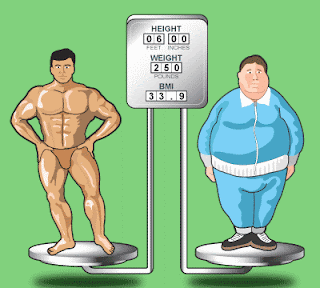 |
| Yoga for Overweight or Obese |
Please remember that you are not sick and not in a problem!
Following information and tips may makes yoga as a perfect solution to overcome obesity or over weight.
What is Obesity or Overweight?
Every one must know before reading this further!
It may be defined as excess weight or deposition of excess fats on body, which leads to various diseases like diabetes, heart diseases, hypertension, lowered pulmonary functions, lowers life expectancy.
Medical words, it may be defined as an abnormal growth of the adipose tissue due to enlargement of fat cell size (Hypertrophic) or an increase in fat cell number (Hyperplastic). It can be of 2 types, first is Abdominal obesity and second is Gluteal obesity. Generally 20 % excess weight is considered as health risk.
Obesity Reasons
Physical inactivity (lack of proper exercise)
Eating Habits -
1. Eating in between meals
2. Preference to sweets, refined food, fats, preserved food
3. Composition & periodicity of meals
Psychological Factors
1. Emotional disturbances
2. Depression and anxiety
3. Frustration and loneliness
Endocrine glands problems
Familial tendency
Males are at high risk during age 29 to 35 and females are at risk during the age 45 to 49
The risk increases with age.
Assessment of Obesity
1. Body Mass Index = Weight in kg./ (Height in meter)* (Height in meter)
If the BMI is in between 19 to 23, it is considered as normal, but if it is more then 23 then it can be called as obesity.
2. Waist to Hip ratio = if it is more than 1 in male is Obesity and 0.85 in females.
There are other methods to assess the obesity.
The obesity results in various diseases like diabetes mellitus, hypertension, coronary heart diseases, reduced pulmonary functions and resulting in lower life expectancy.
The following are some basic Asanas or Yoga Poses for Obesity and Diabetes:

|
Easy Pose (Sukhasana)
This is one of the classic Meditative Poses and is usually performed
after doing the Corpse Pose. The Easy Pose helps in straightening the
spine, slowing down metabolism, promoting inner tranquility, and keeping
your mind still.
|

|
Shoulder Stretches
Shoulder Stretches are great in relieving stress and tension on your
shoulders, as well as your entire upper back. Practice them daily for
several weeks and notice the changes. Learn some basic stretches for the
shoulders in this section.
|

|
Sun Salutation (Surya Namaskar)
The Sun Salutation or Surya Namaskar is a Yoga Pose which limbers up the whole body in preparation for the Yoga Asanas. It is a graceful sequence of twelve Yoga positions performed as one continuous exercise. Learn how to practice Sun Salutation in this section.
|

|
Half Spinal Twist (Ardha Matsyendrasana)
If done properly, the Half Spinal Twist lengthens and strengthens the
spine. It is also beneficial for your liver, kidneys, as well as adrenal
glands. Practice this Yoga Pose under the supervision of a Yoga instructor. In this section, learn how to perform the Half Spinal Twist.
|

|
Stand Spread Leg Forward Fold
Practicing the Standing Spread Leg Forward Fold can strengthen and
stretch your inner and back legs and your spine. People with lower back
problems should avoid doing the full forward bend. For beginners, you may use props like a folding chair to support your forearms.
|

|
Tree Pose (Tadasana)
The Tree Pose helps strengthen your thighs, calves, ankles and back. It
can also increase the flexibility of your hips and groin. Your balance
and concentration can also be improved with constant practice. This Yoga
Pose is recommended for people who have sciatica and flat feet.
|

|
Double Leg Raises
A Double Leg Raise is similar to a Single Leg Raise, only this time, you
will raise both legs.
In doing this Yoga Pose, make sure that the full length of your back is
resting on the floor and your shoulders and neck are relaxed. This
section covers the steps and guidelines on how to do this pose properly.
|

|
Fish Pose (Matsyasana)
Doing the Fish Pose relieves stiffness of the neck and shoulder muscles
and improves flexibility of your spine. It is the counter-pose of the
Shoulderstand. Hold the Fish Pose for at least half the amount of time
you spent in the Shoulderstand in order to balance the stretch.
|

|
Yoga Exercise - Corpse Pose (Savasana)
The Corpse Yoga Pose is considered as a classic relaxation Yoga Pose and
is practiced before or in between Asanas as well as a Final Relaxation.
While it looks deceptively simple, it is actually difficult to perform.
Learn more on how to do it with the help of this article.
|

|
Kapalabhati
Kapalabhati is a Breathing Technique used specifically for cleansing. If
you have a lot of mucus in the air passages or feel tension and
blockages in the chest it is often helpful to breathe quickly. This
article will introduce you to this breathing techniques and show you its
its benefits.
|
 |
Simple Meditation Technique
This Meditation process is good to induce relaxation response and promotes a peaceful and relaxed mind.
Meditation has also been scientifically proven to have health benefits
such as lowering blood pressure and aiding the asthmatics in their
breathing. |

|
Anuloma Viloma
Anuloma Viloma is also called the Alternate Nostril Breathing Technique.
In this Breathing Technique, you inhale through one nostril, retain the
breath, and exhale through the other nostril. Learn how to do this
technique for beginners by following the steps found in this article.
|
 |
Relaxation Pose
There are three parts to proper relaxation - physical, mental and
spiritual relaxation. Relaxation Yoga Pose relaxes your body and mind,
and makes you feel refreshed after doing the Asanas and the pranayama.
This is why it is an essential part of Yoga practice. |
Courtesy Source: yogapoint.com, abc-of-yoga.com


